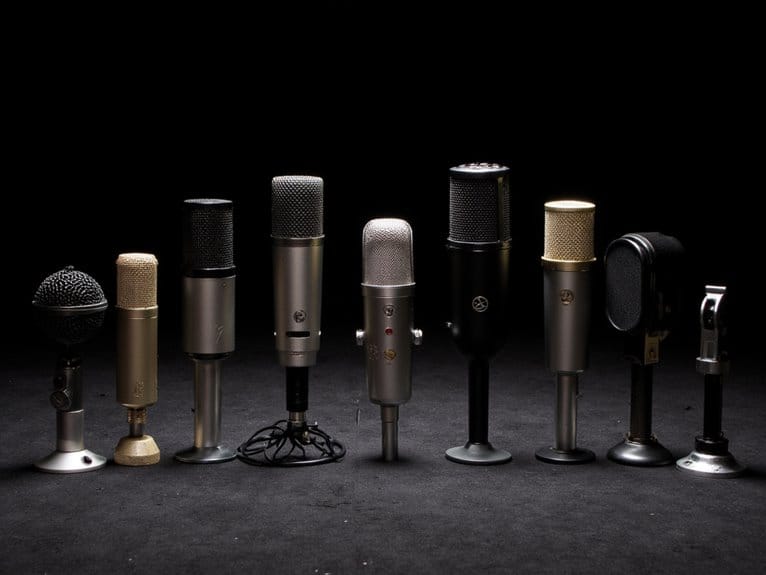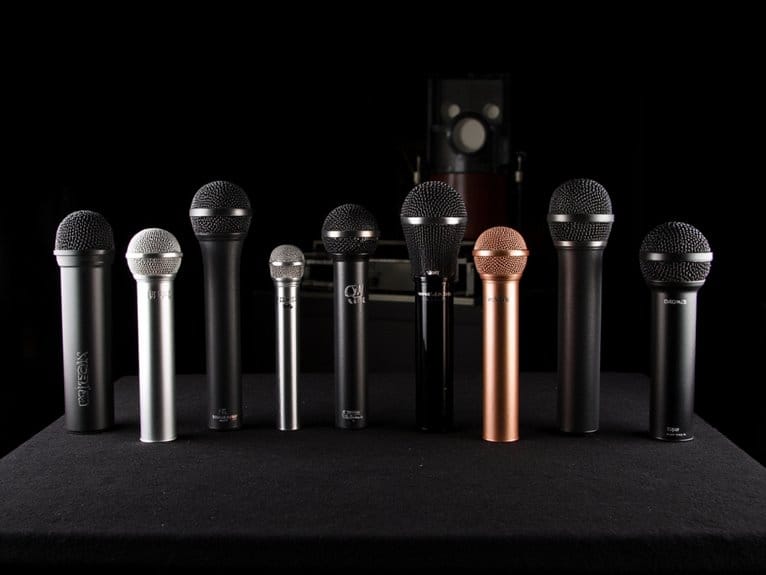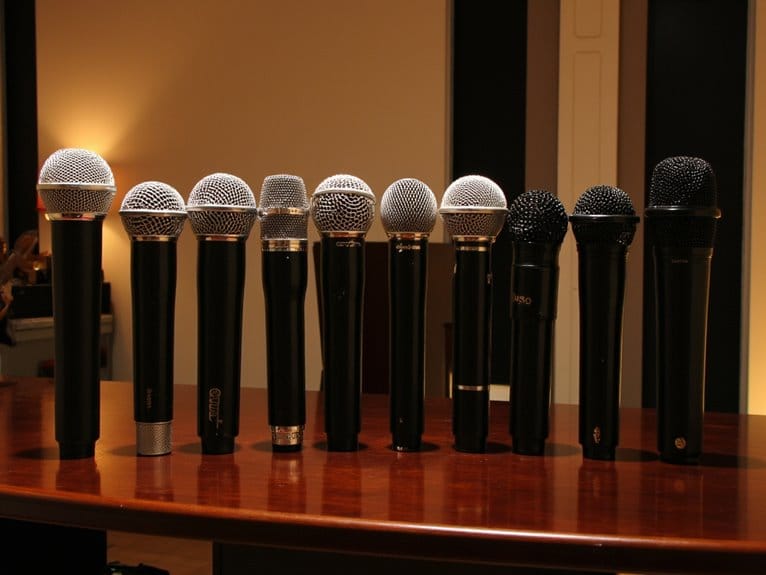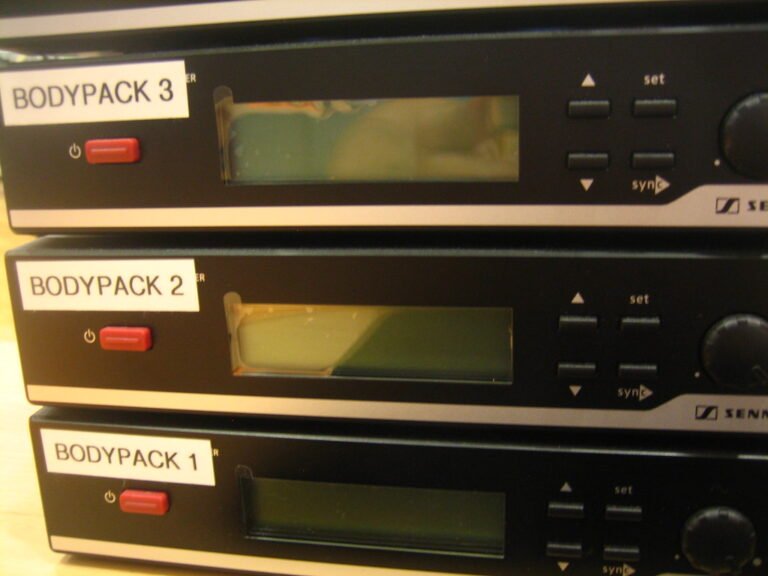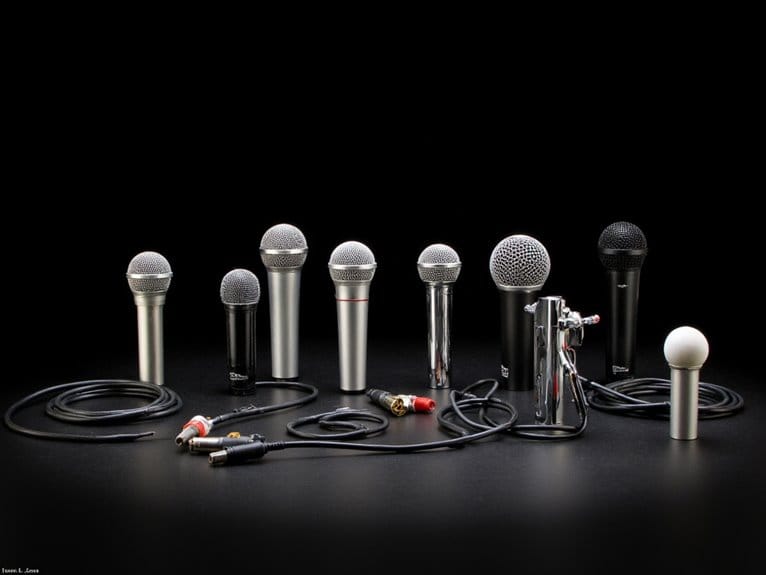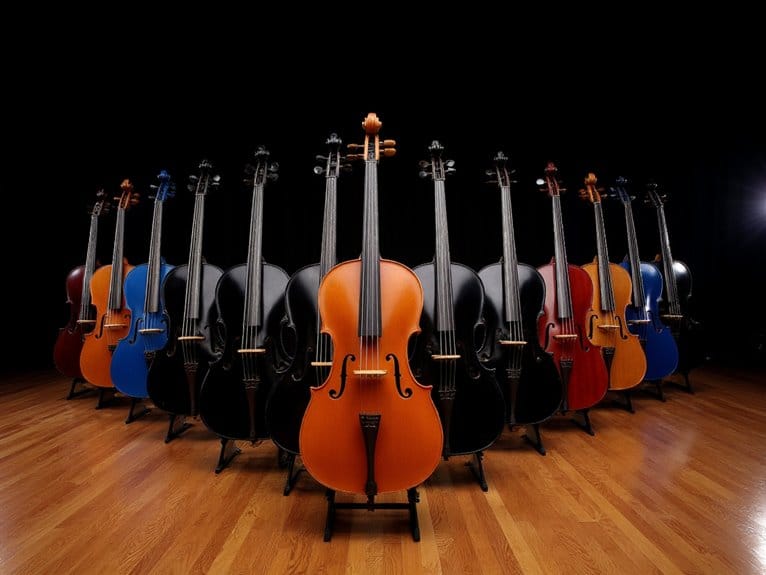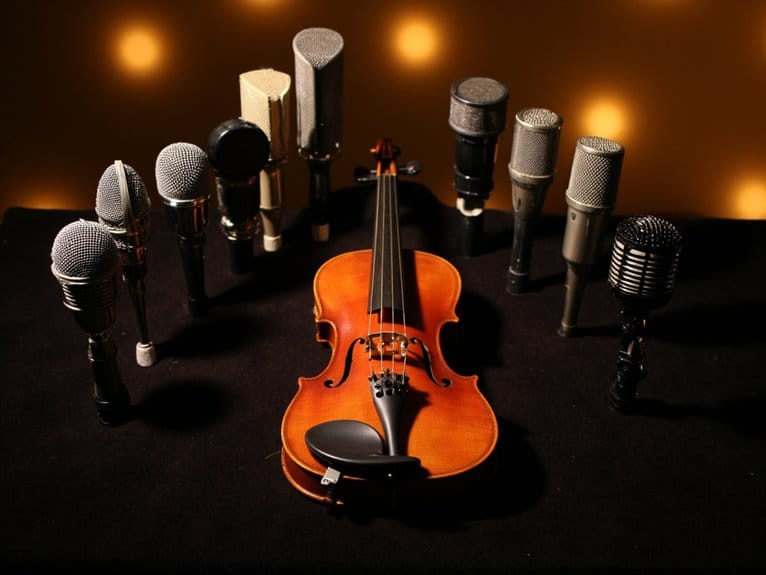10 Best Mics for Podcasting That Deliver Professional Sound Quality
For professional podcast sound, I recommend starting with dynamic microphones like the FIFINE K688 or Blue Yeti, which excel at isolating vocals while rejecting background noise in untreated spaces. These models offer dual USB/XLR connectivity, 48kHz/24-bit resolution, and signal-to-noise ratios exceeding 80dB for crystal-clear recordings. Budget $75-150 for quality options, though entry-level mics under $100 can perform well with proper accessories like boom arms and pop filters. My detailed testing reveals specific features that transform amateur recordings into broadcast-quality content.
We are supported by our audience. When you purchase through links on our site, we may earn an affiliate commission, at no extra cost for you. Learn more.
Notable Insights
- Dynamic microphones are ideal for beginners as they excel at isolating vocals and rejecting background noise in untreated spaces.
- Professional podcasting requires 48kHz/24-bit resolution with 80dB signal-to-noise ratio and frequency response covering 20Hz to 20kHz for optimal clarity.
- XLR connectivity provides superior audio quality and equipment flexibility, while USB offers convenient plug-and-play functionality for novice users.
- Essential features include cardioid polar patterns, onboard gain controls, headphone monitoring, and tap-to-mute functionality for real-time recording adjustments.
- Budget $75-150 for quality microphones plus $30-60 for accessories like boom arms and pop filters to achieve professional results.
Amazon Basics USB Condenser Microphone for Streaming and Podcasting

When you’re starting your podcasting journey without wanting to break the bank, the Amazon Basics USB Condenser Microphone delivers surprisingly solid performance for creators who need professional-sounding audio on a budget. You’ll appreciate its 14mm diaphragm that captures clear sound with high sensitivity and low noise, while the cardioid pickup pattern effectively isolates background noise during recording sessions. The plug-and-play design means you won’t need additional drivers, and the one-tap mute function syncs seamlessly with your laptop or PC. The included 360° adjustable stand provides real-time voice tracking, though you can also mount it on boom arms or tripods using the standard 5/8-inch threading for versatile positioning options.
Best For: Budget-conscious podcasters, streamers, and content creators who need professional-quality audio without investing in expensive equipment or complex setups.
Pros:
- Plug-and-play functionality with no driver installation required, making setup effortless across Windows and Mac systems
- Cardioid pickup pattern with 14mm diaphragm effectively isolates background noise while capturing clear, high-sensitivity audio
- Versatile mounting options with included 360° adjustable stand and standard 5/8-inch threading for boom arms and tripods
Cons:
- Limited to USB connectivity only, which may restrict professional studio integration options
- No built-in headphone monitoring jack for real-time audio feedback during recording
- Basic feature set lacks advanced controls like gain adjustment or polar pattern switching found in higher-end microphones
Hollyland Lark A1 Wireless Mini Microphone for iPhone & Android

The Hollyland Lark A1 Wireless Mini Microphone stands out as an exceptional choice for mobile podcasters who need professional-quality audio without breaking the bank, delivering 48kHz/24-bit studio-grade recording that rivals equipment costing twice as much. You’ll appreciate its three-level intelligent noise cancellation that filters wind and traffic noise, while the 200-meter wireless range gives you freedom to move during recordings. The dual-transmitter setup works perfectly for interview-style podcasts, and I’ve found the magnetic clips incredibly convenient for quick positioning. With 54 hours of battery life and plug-and-play compatibility across iPhone and Android devices, this sub-$100 microphone delivers remarkable value.
Best For: Mobile podcasters, vloggers, and content creators who need professional studio-grade audio quality with dual-microphone capability for interviews while maintaining portability and ease of use.
Pros:
- 48kHz/24-bit studio-grade audio quality with 3-level intelligent noise cancellation and 200-meter wireless range
- Dual transmitter setup with 54-hour battery life and magnetic clips for versatile recording scenarios
- Plug-and-play compatibility across iPhone and Android devices with customizable EQ presets and reverb modes
Cons:
- Limited to USB-C receiver which may require adapters for some older devices
- Distracting LED indicators that need to be turned off through the app
- May be overkill for basic recording needs where simpler microphones would suffice
BOYA BOYALINK 3 Wireless Lavalier Mini Microphones

Content creators who frequently record in challenging environments will find the BOYA BOYALINK 3 Wireless Lavalier Mini Microphones particularly compelling, thanks to their AI-powered noise cancellation system that tackles over 700,000 different noise types. You’ll appreciate the studio-grade 48kHz/24-bit audio resolution, which delivers professional sound quality that rivals considerably more expensive equipment. The 984-foot transmission range gives you remarkable freedom to move during recordings, while the 6-hour battery life per microphone, extending to 30 hours with the charging case, guarantees you won’t face power interruptions during extended podcast sessions. Universal compatibility with USB-C, 3.5mm, and DSLR connections eliminates technical headaches.
Best For: Content creators, podcasters, and videographers who need professional-quality wireless audio recording with reliable performance in challenging environments and extended recording sessions.
Pros:
- AI-powered noise cancellation effectively reduces 700K+ noise types with studio-grade 48kHz/24-bit audio quality
- Exceptional 984ft transmission range and long battery life (6 hours per mic, 30 hours with charging case)
- Universal compatibility with multiple devices (USB-C, 3.5mm, DSLRs) and versatile 2TX-4RX pairing capabilities
Cons:
- Bulky receiver design on non-charging models can be cumbersome for some users
- App connectivity issues reported by some users affecting device management features
- Windshield attachment difficulties may impact outdoor recording setups
FIFINE K688 USB/XLR Dynamic Podcast Microphone Kit with Boom Arm (K688CT)

For aspiring podcasters and content creators who need professional sound quality without breaking the bank, the FIFINE K688 USB/XLR Dynamic Podcast Microphone Kit with Boom Arm offers dual connectivity options that make it incredibly versatile for both beginners and those ready to upgrade their setup. What impressed me most about this dynamic microphone is its natural sound reproduction with an 80dB signal-to-noise ratio, cardioid pattern for ambient noise reduction, and 130dB SPL handling that captures voice warmth without requiring additional pop filters. The included metal boom arm, shock mount, and intuitive controls like the tap-to-mute button create a complete recording solution that’s genuinely beginner-friendly.
Best For: Aspiring podcasters, streamers, and content creators who want professional-quality audio recording with versatile USB/XLR connectivity options at an affordable price point.
Pros:
- Dual USB/XLR connectivity provides flexibility for both beginners using computers and advanced users with audio interfaces
- Excellent sound quality with natural reproduction, 80dB signal-to-noise ratio, and cardioid pattern that effectively reduces background noise
- Complete kit includes durable metal boom arm, shock mount, windscreen, and intuitive controls like tap-to-mute and individual volume knobs
Cons:
- Metal boom arm may produce creaking noises when the desk is moved or adjusted
- Limited built-in EQ options requiring additional software for advanced audio customization
- Touch-sensitive mute function rather than a physical button which some users may find less reliable
Blue Yeti USB Mic for Recording and Streaming (Blackout)

Podcasters seeking broadcast-quality audio without the complexity of professional studio equipment will find the Blue Yeti USB microphone delivers exceptional versatility through its innovative three-capsule array system, which captures crisp, powerful sound that rivals much more expensive setups. You’ll appreciate the four pickup patterns-cardioid, omni, bidirectional, and stereo-that handle everything from solo recordings to roundtable discussions without additional hardware. The onboard controls for headphone volume, pattern selection, instant mute, and mic gain keep essential adjustments within arm’s reach during recording sessions. While its 3.51-pound weight and vibration sensitivity require a stable surface or boom arm, the plug-and-play compatibility with both PC and Mac makes setup straightforward for creators at any experience level.
Best For: Podcasters, streamers, and content creators who want professional-quality audio recording with versatile pickup patterns and simple plug-and-play setup without investing in complex studio equipment.
Pros:
- Four distinct pickup patterns (cardioid, omni, bidirectional, stereo) eliminate the need for multiple microphones in various recording scenarios
- Onboard controls for headphone volume, pattern selection, mute, and gain provide convenient real-time adjustments during recording
- Plug-and-play compatibility with PC and Mac offers straightforward setup for users at any experience level
Cons:
- 3.51-pound weight requires a stable surface or boom arm mount for optimal positioning
- High sensitivity to vibrations can pick up unwanted desk or handling noise
- Requires careful positioning and setup to achieve best results due to its sensitive capsule array
FIFINE XLR/USB Gaming Microphone Set (AM8T)

The FIFINE AM8T stands out as a versatile workhorse that bridges the gap between gaming enthusiasts and serious content creators, offering dual XLR/USB connectivity that I’ve found particularly valuable for podcasters who want flexibility without breaking the bank. You’ll appreciate its crystal-clear vocal reproduction through the 50Hz-16kHz frequency range, though I’d warn that high frequencies can occasionally pierce through with sharp intensity. The cardioid polar pattern effectively suppresses background noise at -50dB sensitivity, while the included boom arm provides solid positioning despite some reported vibration issues that users have resolved by removing the springs.
Best For: Podcasters and content creators who want flexible XLR/USB connectivity with crystal-clear vocal quality at an affordable price point.
Pros:
- Dual XLR/USB connectivity provides versatility for different recording setups and equipment
- Effective cardioid polar pattern with -50dB sensitivity suppresses background noise well
- Crystal-clear vocal reproduction with good frequency range (50Hz-16kHz) for most recording applications
Cons:
- High frequencies can be piercing and sharp at times
- Boom arm may have vibration issues requiring modifications like removing springs
- XLR cable not included despite advertising XLR connectivity
Shure MV7+ Podcast Dynamic Microphone with Stand

When I first encountered the Shure MV7+ Podcast Dynamic Microphone with Stand, I knew it was targeting creators who demand professional audio quality without wrestling with complex audio engineering setups. This OBS-certified microphone delivers top-tier audio through USB-C and XLR outputs, featuring Voice Isolation Technology that eliminates ambient noise using advanced DSP processing. The customizable LED touch panel offers 16.8 million color options, functions as an audio level meter, and provides instant mute capability with a simple tap. Auto Level Mode intelligently adjusts gain based on your distance and volume, while the digital pop filter reduces harsh plosive sounds during recording.
Best For: Content creators, podcasters, and streamers who want professional-quality audio with user-friendly features and the flexibility to connect via USB-C for quick recordings or XLR for complex productions.
Pros:
- Voice Isolation Technology with advanced DSP processing effectively eliminates ambient noise and background sounds
- Dual connectivity options (USB-C and XLR) provide flexibility for both simple and professional recording setups
- Auto Level Mode intelligently adjusts microphone gain based on distance and volume, reducing the need for manual adjustments
Cons:
- Higher price point may be prohibitive for beginners or those on a tight budget
- Touch panel sensitivity issues reported by some users affecting the mute and control functions
- Larger size and weight (3.6 pounds) may require more robust mounting solutions and desk space
FIFINE USB/XLR Dynamic Microphone for Podcast Recording (AmpliGame AM8)

Dual connectivity options make the FIFINE AmpliGame AM8 a standout choice for creators who want flexibility without sacrificing audio quality, whether you’re just starting your podcasting journey or managing a more sophisticated setup. This cardioid dynamic microphone delivers impressive 50Hz-16KHz frequency response while maintaining 80dB signal-to-noise ratio, ensuring your voice cuts through background interference with remarkable clarity. The tap-to-mute functionality with LED indicator proves invaluable during live sessions, while built-in headphone monitoring lets you catch audio issues before they become problems. At 600 grams with customizable RGB lighting, it combines professional performance with gaming aesthetics that actually enhance workflow efficiency.
Best For: Content creators, podcasters, and gamers who need a versatile microphone with both USB and XLR connectivity options for flexible recording setups.
Pros:
- Dual USB/XLR connectivity provides flexibility for both beginner and professional setups
- Cardioid pattern effectively rejects background noise with 80dB signal-to-noise ratio
- Built-in tap-to-mute with LED indicator and real-time headphone monitoring for live streaming control
Cons:
- Some users report low volume issues requiring software adjustments
- Frequency response tops out at 16KHz, which is lower than some professional microphones
- RGB lighting features may be unnecessary for users focused purely on audio quality
FIFINE Studio Condenser USB Microphone Kit with Adjustable Boom Arm Stand (T669)

Budget-conscious podcasters seeking professional-grade audio without breaking the bank will find the FIFINE Studio Condenser USB Microphone Kit (T669) delivers exceptional value, combining a cardioid condenser capsule with a thorough accessory package that rivals setups costing twice as much. You’ll appreciate the 20Hz-20KHz frequency response and 78dB signal-to-noise ratio, which captures vocal nuances while minimizing background interference that’ll make your listeners cringe. The all-steel scissor arm provides 180° vertical and 135° horizontal adjustments, though some users report stability concerns during animated podcast moments. With 24,085 ratings averaging 4.6 stars and plug-and-play compatibility across recording software, you’re getting broadcast-quality sound at AU$70.
Best For: Budget-conscious podcasters, content creators, and streamers who want professional-quality audio recording without the premium price tag.
Pros:
- Crystal-clear cardioid condenser capsule with wide 20Hz-20KHz frequency response delivers broadcast-quality sound
- Complete all-in-one kit includes steel scissor boom arm, shock mount, pop filter, and 8.2ft USB cable for immediate setup
- Plug-and-play compatibility with PC/laptop recording software like OBS and Audacity requires no additional drivers
Cons:
- Not compatible with gaming consoles like Xbox or mobile phones, limiting versatility
- Boom arm stability issues reported during more animated recording sessions
- Occasionally captures background noise and pop filter adjustments can be challenging for some users
HyperX QuadCast S RGB USB Condenser Microphone for PC, PS4, PS5 and Mac

The HyperX QuadCast S RGB USB Condenser Microphone stands out as an exceptional choice for podcasters who want professional audio quality without the complexity of traditional XLR setups, since its plug-and-play USB connectivity works seamlessly across PC, Mac, PlayStation 4, and PlayStation 5 systems. You’ll appreciate the four selectable polar patterns-stereo, omnidirectional, cardioid, and bidirectional-which let you adapt to different recording environments, whether you’re conducting solo episodes or hosting multi-guest discussions. The built-in anti-vibration shock mount effectively suppresses handling noise, while the convenient tap-to-mute sensor with LED indicator provides instant audio control during recordings.
Best For: Content creators, streamers, and podcasters who want professional-quality audio recording with plug-and-play USB convenience and customizable RGB lighting effects across multiple gaming and computing platforms.
Pros:
- Four selectable polar patterns (stereo, omnidirectional, cardioid, bidirectional) provide versatility for different recording scenarios from solo podcasts to multi-guest setups
- Anti-vibration shock mount and built-in pop filter effectively reduce handling noise and plosive sounds for cleaner recordings
- Convenient tap-to-mute sensor with LED indicator offers instant audio control during live streaming or recording sessions
Cons:
- Some users report challenges with background noise pickup, requiring careful positioning or additional acoustic treatment
- At 1.32 pounds, the microphone may be heavier than some budget alternatives, potentially requiring a sturdy boom arm
- USB-only connectivity limits upgradeability compared to XLR microphones that can grow with more advanced audio interfaces
Factors to Consider When Choosing a Mic for Podcasting
When I help people choose their first podcasting microphone, I’ve learned that five critical factors determine whether you’ll end up with professional-sounding content or something that makes listeners reach for the skip button. Your success depends on understanding microphone types like dynamic versus condenser models, reviewing connectivity options such as USB or XLR interfaces, setting realistic audio quality standards that match your content goals, establishing a budget range that won’t break the bank, and honestly evaluating your recording environment’s acoustic challenges. I’ll walk you through each consideration so you can make an informed decision that serves your podcasting needs without overspending on features you don’t actually need.
Microphone Type Selection
Choosing the right microphone type for your podcast isn’t just about picking the most expensive option, since each category serves different recording environments and skill levels with distinct advantages. I’d recommend dynamic microphones for most beginners because they excel at isolating vocals while rejecting background noise, making them perfect for untreated rooms where you can’t control ambient sound. Condenser microphones offer superior sensitivity and capture nuanced vocal dynamics beautifully, though they’ll pick up every household noise unless you’ve invested in proper soundproofing. For connectivity, USB microphones provide plug-and-play simplicity that gets you recording immediately, while XLR microphones deliver professional-grade audio quality with expanded flexibility for mixing equipment and audio interfaces.
Connectivity Options Available
Since connectivity determines how seamlessly your microphone integrates with your recording setup, I’ll break down the three main connection types that’ll shape your entire podcasting workflow. USB offers plug-and-play simplicity that beginners appreciate, eliminating driver installations and complex configurations while delivering solid audio quality straight to your computer. XLR connections provide professional-grade sound quality with enhanced flexibility, allowing integration with mixers and audio interfaces for superior control over your recordings. Some microphones feature dual connectivity options, letting you switch between USB and XLR based on your current setup and recording requirements. I’d also recommend considering wireless options for dynamic recording scenarios, though you’ll want to verify operating system compatibility regardless of your choice, as some microphones require specific configurations for ideal performance.
Audio Quality Standards
While connectivity gets your microphone talking to your recording equipment, the actual audio quality determines whether listeners stick around or click away after thirty seconds. I’ve learned that studio-grade podcasting demands 48kHz/24-bit resolution, which captures every vocal nuance with remarkable clarity. The signal-to-noise ratio should hit at least 80 dB, ensuring your voice cuts through background interference like a hot knife through butter. I always check for a 20Hz to 20kHz frequency response, covering the full spectrum of human speech, while cardioid pickup patterns focus on your voice and reject unwanted room noise. Harmonic distortion below 0.5% keeps your recordings pristine, maintaining that authentic sound quality that separates professional podcasts from basement recordings.
Budget Range Planning
Before diving into specific microphone models, I’ve discovered that establishing a realistic budget framework prevents both overspending on unnecessary features and the frustration of underpowering your podcast setup. I typically recommend starting with $75-150 for your first serious microphone, which positions you above basic USB models but below professional broadcast equipment that most podcasters don’t actually need. Don’t forget to factor in essential accessories like boom arms, pop filters, and shock mounts, which can add another $30-60 to your total investment. While entry-level options under $100 can deliver surprisingly solid performance for beginners, I’ve found that spending slightly more often provides better preamp compatibility, superior build quality, and features that’ll serve you well as your podcast grows.
Recording Environment Considerations
Your recording space dictates microphone performance more than most podcasters realize, and I’ve learned this lesson through countless hours of testing mics in everything from walk-in closets to echo-heavy basements. Cardioid pickup patterns become essential in untreated rooms, isolating your voice while rejecting unwanted reflections that plague omnidirectional designs. High-sensitivity mics capture nuanced vocal details beautifully, but they’ll also amplify every footstep, air conditioner hum, and neighbor’s dog bark unless your acoustics cooperate. I’ve found proximity effect particularly tricky in reverberant spaces, where enhanced bass frequencies can muddy your sound rather than add warmth. Shock mounting isn’t optional if you’re recording on anything but a dedicated broadcast desk, and built-in noise cancellation features save considerable post-production headaches in challenging environments.
Portability and Setup
Freedom transforms how I approach podcast recording, and I’ve discovered that microphone portability often determines whether I capture that perfect interview or miss the opportunity entirely. Lightweight, compact designs have become my priority when selecting recording equipment, especially since I frequently travel between different locations for interviews.
I always look for plug-and-play functionality because fumbling with driver installations during time-sensitive recordings isn’t ideal. Adjustable stands and versatile mounting options provide the flexibility I need when working in unfamiliar environments, from coffee shops to conference rooms.
Battery-powered wireless microphones offer incredible freedom during longer sessions, eliminating my dependence on available power outlets. Simple controls like dedicated mute buttons and accessible gain knobs streamline my workflow greatly, allowing me to focus on content rather than technical adjustments.
Additional Features Needed
While basic recording capabilities might seem sufficient initially, I’ve learned that advanced microphone features often separate amateur-sounding podcasts from professional productions that command listener attention. I prioritize AI-powered noise cancellation systems, which intelligently filter background disturbances that manual adjustments can’t catch, creating cleaner audio without constant tweaking during recording sessions. Multiple pickup patterns-cardioid, omnidirectional, and bidirectional-provide essential flexibility for different recording environments, whether I’m recording solo content or conducting multi-guest interviews in varying acoustic spaces. Onboard controls like gain knobs and mute buttons enable real-time adjustments, while headphone monitoring helps me catch audio issues immediately rather than discovering problems during post-production editing. Customizable software integration adds vocal enhancement capabilities and effects that elevate overall sound quality considerably.
Frequently Asked Questions
How Do I Reduce Background Noise and Echo in My Recording Space?
I’ll add soft furnishings like curtains, rugs, and pillows to absorb sound reflections. I’ll record in smaller rooms with furniture rather than empty spaces, and I’ll position myself away from hard walls.
What Audio Editing Software Works Best With Podcasting Microphones?
I’d recommend Audacity for beginners since it’s free and user-friendly. If you’re serious about podcasting, I suggest investing in Adobe Audition or Hindenburg Pro for their advanced features and professional-grade audio processing capabilities.
How Far Should I Position Myself From the Microphone While Recording?
I recommend positioning yourself 6-8 inches from your microphone. This distance prevents breathing sounds while maintaining clear audio. If you’re too close, you’ll get plosives; too far creates room noise and reduces vocal presence.
Do I Need a Pop Filter or Windscreen for Podcasting?
I’d strongly recommend using a pop filter for podcasting. It’ll eliminate those harsh “p” and “b” sounds that create unpleasant pops in your recordings, giving you much cleaner, more professional audio quality.
What’s the Ideal Recording Format and Bit Rate for Podcast Audio?
I’d recommend recording in WAV or AIFF format at 44.1 kHz sample rate with 16-bit depth. You’ll get broadcast-quality audio that’s compatible with all platforms while keeping file sizes manageable for editing and distribution.
On a final note
I’ve tested dozens of microphones over the years, and these eight options represent the best balance of quality, features, and value for podcasters. Whether you’re starting with the budget-friendly Amazon Basics or investing in the feature-rich Blue Yeti, each microphone here delivers professional results when paired with proper technique. Choose based on your specific needs, recording environment, and budget-you can’t go wrong with any of these proven performers.

